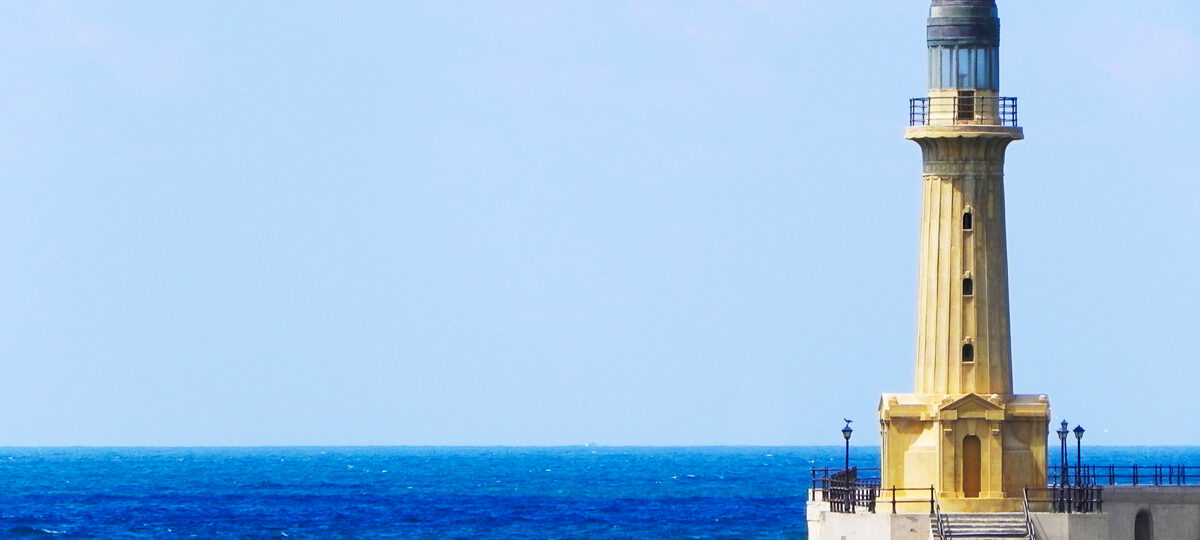Lighthouse of Alexandria
The Pharos of Alexandria, or Lighthouse of Alexandria, was constructed in the 4th century BCE and was one of the Seven Wonders of the Ancient World. Until the Eiffel Tower was built in 1889, it was the tallest structure in the world.
Historians agree that the construction of the lighthouse was crucial since it ensured the safe return of sailors from the Mediterranean Sea to Great Harbor. As the tallest building ever constructed, it was of utmost importance to architects. And the mystery it presented was interesting and thrilling for researchers. Because of how impressive it was, it was included on the list of the ancient civilization’s honorific “Seven Wonders of the World.”
Sailors relied on the Lighthouse, the light during the day, and the fire at night to navigate the Atlantic Ocean. Even after a devastating earthquake in 1323 A.D., the lighthouse continued to serve its purpose until its destruction. This was when Sultan Qayetbay came, fortified the region as part of his coastal defences, and built his fortress there.
Tell me, where in Alexandria is the famous lighthouse?
Its original location was on the southeastern tip of Pharos Island, outside of Alexandria, Egypt’s main city on the country’s northern coast.

Why did people decide to build a lighthouse in Alexandria?
The lighthouse was used by hundreds of ships each year to find their way into the harbour. A mirror atop the lighthouse would reflect the sun’s rays and help sailors find their way when the weather was clear. Without access to electricity, people relied on fire to see through the dark. Some say it was so powerful that it could be seen from 100 miles out to sea.
Who built it and when did it get built?
The temple to Zeus was begun during the reign of Ptolemy II and completed during the reign of Ptolemy III (280-247 BC). During Alexander the Great’s rule, the famous Lighthouse of Alexandria was constructed. The lighthouse was constructed in the third century BC, when Alexander the Great had just passed away and Egypt had been returned to Greek rule. It was consecrated in 305 BC, the year that Ptolemy I Soter succeeded to the throne of Egypt. The construction of the Lighthouse on the Rocks was a political priority for Ptolemy while he was in charge. Under the rule of Ptolemy’s son and successor, Ptolemy II Philadelphus, the towering building was finally finished.

A total of 800 talents of silver were used in the construction of the building, which took 12 years to finish. At 300 feet, the Lighthouse was the world’s second-tallest structure after the Great Pyramids of Giza. Since the Lighthouse of Alexandria was destroyed by an earthquake in 1323 AD, much of what is known about its construction is conjectural at best.
The tower of the lighthouse was built using massive blocks of white stone. The tower has three gradually diminishing storeys. Lower square portion with centre core; octagonal section; and top circular section made up the first, second, and third parts, respectively.
That was the architect who created the Lighthouse of Alexandria?
The architect from Cnidus named Sostratus built the beacon. Among Cnidian businessmen, Sostratus of Cnidus stands out as a titan. He had access to the highest levels of government since he was related to both King Ptolemy I and the king’s son.
Has the lighthouse in Alexandria been turned off?
Although it served its purpose for close to 1,500 years, the lighthouse is now out of commission. Since its inception, Egypt has had many administrations and fought several conflicts, one of which resulted in the destruction of the Alexandria Library.
Finalization of the Lighthouse of Alexandria’s construction
Following two earthquakes in 796 and 951, the Lighthouse of Alexandria sustained minor damage but remained standing; however, after three more earthquakes in 1303 and 1323, the Lighthouse was entirely demolished. The 1303 earthquake that started on the Greek island of Crete is often regarded as the most destructive natural disaster ever documented. In 1480, the Egyptian Sultan Qaitbay ordered the construction of t

